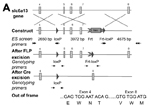Slc6a13tm1.2Ncd
Targeted Allele Detail
|
|
| Symbol: |
Slc6a13tm1.2Ncd |
| Name: |
solute carrier family 6 (neurotransmitter transporter, GABA), member 13; targeted mutation 1.2, NC Danbolt |
| MGI ID: |
MGI:5466690 |
| Synonyms: |
GAT2-fKO |
| Gene: |
Slc6a13 Location: Chr6:121277247-121314680 bp, + strand Genetic Position: Chr6, 57.22 cM, cytoband F1
|
| Alliance: |
Slc6a13tm1.2Ncd page
|
|
|
|
| Allele Type: |
|
Targeted (Null/knockout) |
| Mutations: |
|
Insertion, Intragenic deletion
|
| |
|
Mutation details: A loxP site was inserted upstream of exon 5. An FRT-flanked neo cassette with a 3' loxP site was inserted downstream of exon 7. Cre-mediated recombination removed exons 5 through 7. This allele lacks the neo cassette. Immunohistochemistry confirmed the absence of protein expression in the brain.
(J:191581)
|
|
Generation of the Slc6a13tm1.1Ncd and Slc6a13tm1.2Ncd alleles |

|
|
View phenotypes and curated references for all genotypes (concatenated display).
|
| Mouse strains and cell lines
available from the International Mouse Strain Resource
(IMSR) |
| Carrying this Mutation: |
Mouse Strains: 0 strains available
Cell Lines: 0 lines available
|
| Carrying any Slc6a13 Mutation: |
47 strains or lines available
|
|
| Original: |
J:191581 Zhou Y, et al., Deletion of the gamma-aminobutyric acid transporter 2 (GAT2 and SLC6A13) gene in mice leads to changes in liver and brain taurine contents. J Biol Chem. 2012 Oct 12;287(42):35733-46 |
| All: |
1 reference(s) |
|
 Analysis Tools
Analysis Tools





